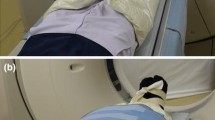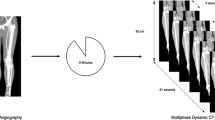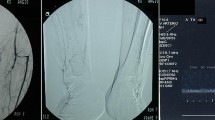Abstract
The aim of this study was to evaluate the potential of multislice CT angiography (CTA) in detecting hemodynamically significant (≥70%) lesions of lower extremity inflow and runoff arteries. Fifty patients (42 men, 8 women; mean age 68 years) with peripheral arterial occlusive disease underwent multislice spiral CTA and digital subtraction angiography (DSA) from the infrarenal aorta to the supramalleolar region. CT parameters were 4×2.5-mm collimation, 15-mm table increment/rotation (pitch 6), and 1.25-mm reconstruction increment. Semitransparent volume rendering technique (STVR) images with semitransparent display of the arterial lumen (opacity: 50%) and vascular calcifications (opacity: 20%), as well as maximum intensity projection (MIP), and MIP together with axial CT studies were independently reviewed for hemodynamically significant lesions (≥70% cross-sectional area reduction). DSA was the standard of reference. In 46 patients, 260 lesions were found (95 stenoses, 165 occlusions). For detecting ≥70% lesions in all vessel regions, sensitivity and specificity were 84% and 78% (STVR), 89% and 74% (MIP), and 92% and 83% (MIP+axial CT), respectively, with a significantly lower sensitivity of STVR (p<0.05) and a significantly lower specificity of MIP studies (p<0.01). Sensitivity and specificity were, respectively, 81% and 93% (STVR), 88% and 75% (MIP). and 92% and 95% (MIP+axial CT) at aortoiliac arteries, 92% and 73% (STVR), 95% and 70% (MIP) and 98% and 70% (MIP+axial CT) at femoropopliteal arteries, as well as 82% and 64% (STVR), 86% and 74% (MIP), and 90% and 74% (MIP+axial CT) at infrapopliteal arteries. Specificity of MIP-CTA was significantly lower in the aortoiliac region (p<0.01), whereas STVR revealed significantly lower specificity at infrapopliteal arteries (p<0.05). In the infrapopliteal region, the particular CTA imaging modalities led to misinterpretation regarding stenoses and occlusions in 39–45 cases, whereas only 0–6 significant aortoiliac and femoropopliteal lesions were misinterpreted. Multislice CTA is helpful in detecting hemodynamically significant lesions in peripheral arterial occlusive disease. Since axial CT studies yielded the most correct results, they should always be reviewed additionally. In the infrapopliteal region, exact lesion assessment remains problematic due to small vessel diameters.



Similar content being viewed by others
References
Fuchs T, Kachelriess M, Kalender W (2000) Technical advances in multi-slice spiral CT. Eur J Radiol 36:69–73
Fleischmann D (2002) Present and future trends in multiple detector-row CT applications: CT angiography. Eur Radiol 12[Suppl 2]:11–16
Klingenbeck-Regn K, Schaller S, Flohr T, Ohnesorge B, Kopp AF, Baum U (1999) Subsecond multi-slice computed tomography: basics and applications. Eur J Radiol 31:110–124
Ohnesorge B, Flohr T, Schaller S, Klingenbeck-Regn K, Becker C, Schöpf UJ, Brüning R, Reiser MF (1999) Principles and applications of multi-slice CT. Radiologe 39:923–931
Rubin GD, Schmidt AJ, Logan LJ, Sofilos MC (2001) Multi-detector row CT angiography of lower extremity arterial inflow and runoff: initial experience. Radiology 221:146–158
Prokop M (2000) Multislice CT angiography. Eur J Radiol 36:86–96
Rubin GD, Shiau MC, Schmidt AJ, Fleischmann D, Logan L, Leung AN, Brooke Jeffrey R, Napel S (1999) Computed tomographic angiography: historical perspective and new state-of-the-art using multi detector—row helical computed tomography. J Comput Assist Tomogr 23[Suppl 1]:83–90
Puls R, Knollmann F, Werk M, Gebauer B, Gaffke G, Steinkamp H, Stroszczynski C, Felix R (2001) Multi-slice spiral CT: 3D CT angiography for evaluating therapeutically relevant stenosis in peripheral arterial occlusive disease. Röntgenpraxis 54:141–147
Ofer A, Nitecki SS, Linn S, Epelman M, Fischer D, Karram T, Litmanovich D, Schwartz H, Hoffmann A, Engel A (2003) Multidetector CT angiography of peripheral vascular disease: a prospective comparison with intraarterial digital subtraction angiography. Am J Roentgenol 180:719–724
Martin ML, Tay KH, Flak B, Fry PD, Doyle DL, Taylor DC, Hsiang YN, Machan LS (2003) Multidetector CT angiography of the aortoiliac system and lower extremities: a prospective comparison with digital subtraction angiography. Am J Roentgenol 180:1085–1091
Funke C, Alamo L, Castillo E, Kopka L, Grabbe E (2000) Multislice CT angiography: optimization of scan parameters in a vascular phantom. Fortschr Röntgenstr 173:927–933
Ney D, Fishman EK, Magid D, Drebin RA (1990) Volumetric rendering of computed tomography data: principles and techniques. IEEE Comp Graph Appl 10:19–27
Landis JR, Koch GG (1977) The measurement of observer agreement for categorical data. Biometrics 33:159–174
Diederichs CG, Keating DP, Glatting G, Oestmann JW (1996) Blurring of vessels in spiral CT angiography: effects of collimation width, pitch, viewing plane, and windowing in maximum intensity projection. J Comput Assist Tomogr 20:965–974
Kanitsar A, Wegenkittl R, Felkel P, Sandner D, Groeller E, Fleischmann D (2001) Automated vessel detection at lower extremity multislice CT angiography. Eur Radiol 11[Suppl 1]:236
Rieker O, Düber C, Schmiedt W, Zitzewitz H, Schweden F, Thelen M (1996) Prospective comparison of CT angiography of the legs with intraarterial digital subtraction angiography. Am J Roentgenol 166:269–276
Rieker O, Mildenberger P, Neufang A, Zitzewitz H, Schweden F, Thelen M (1997) CT angiography for peripheral occlusive vascular disease: comparison of 3 rendering techniques. Fortschr Röntgenstr 167:361–370
Walter F, Leyder B, Fays J, Bronner J, Lehalle B, Blum A, Roland J (2001) Value of arteriography scanning in lower limb artery evaluation: a preliminary study. J Radiol 82:473–479
Ebert DS, Heath DG, Kuszyk BS, Edwards L, Shaw CD, Kukla J, Bedwell T, Fishman EK (1998) Evaluating the potential and problems of three-dimensional computed tomography measurements of arterial stenosis. J Dig Imaging 11:151–157
Tins B, Oxtoby J, Patel S (2001) Comparison of CT angiography with conventional artery angiography in aortoiliac occlusive disease. Br J Radiol 74:219–225
Bush HP, Hoffmann HG, Metzner C, Oettinger W (1999) MR-angiography of the lower extremities with automatic moving bed (MobiTrak) in comparison to i.a. DSA. Fortschr Röntgenstr 70:275–283
Oliver TB, Lammie GA, Wright AR, Wardlaw J, Patel SG, Peek R, Ruckley CV, Collie DA (1999) Atherosclerotic plaque at the carotid bifurcation: CT angiographic appearance with histopathologic correlation. Am J Neuroradiol 20:897–901
Author information
Authors and Affiliations
Corresponding author
Rights and permissions
About this article
Cite this article
Portugaller, H.R., Schoellnast, H., Hausegger, K.A. et al. Multislice spiral CT angiography in peripheral arterial occlusive disease: a valuable tool in detecting significant arterial lumen narrowing?. Eur Radiol 14, 1681–1687 (2004). https://doi.org/10.1007/s00330-004-2289-1
Received:
Revised:
Accepted:
Published:
Issue Date:
DOI: https://doi.org/10.1007/s00330-004-2289-1




